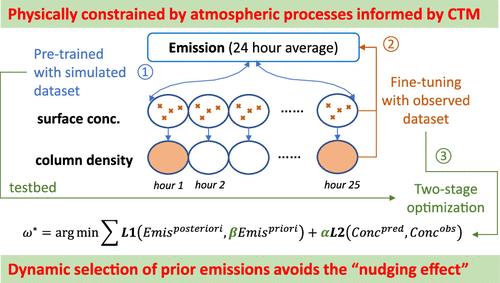当前位置:
X-MOL 学术
›
Environ. Sci. Technol.
›
论文详情
Our official English website, www.x-mol.net, welcomes your
feedback! (Note: you will need to create a separate account there.)
A Physically Constrained Deep-Learning Fusion Method for Estimating Surface NO2 Concentration from Satellite and Ground Monitors
Environmental Science & Technology ( IF 10.8 ) Pub Date : 2024-11-20 , DOI: 10.1021/acs.est.4c07341 Jia Xing, Bok H. Baek, Siwei Li, Chi-Tsan Wang, Ge Song, Siqi Ma, Shuxin Zheng, Chang Liu, Daniel Tong, Jung-Hun Woo, Tie-Yan Liu, Joshua S. Fu
Environmental Science & Technology ( IF 10.8 ) Pub Date : 2024-11-20 , DOI: 10.1021/acs.est.4c07341 Jia Xing, Bok H. Baek, Siwei Li, Chi-Tsan Wang, Ge Song, Siqi Ma, Shuxin Zheng, Chang Liu, Daniel Tong, Jung-Hun Woo, Tie-Yan Liu, Joshua S. Fu

|
Accurate estimation of atmospheric chemical concentrations from multiple observations is crucial for assessing the health effects of air pollution. However, existing methods are limited by imbalanced samples from observations. Here, we introduce a novel deep-learning model-measurement fusion method (DeepMMF) constrained by physical laws inferred from a chemical transport model (CTM) to estimate NO2 concentrations over the Continental United States (CONUS). By pretraining with spatiotemporally complete CTM simulations, fine-tuning with satellite and ground measurements, and employing a novel optimization strategy for selecting proper prior emission, DeepMMF delivers improved NO2 estimates, showing greater consistency and daily variation alignment with observations (with NMB reduced from −0.3 to −0.1 compared to original CTM simulations). More importantly, DeepMMF effectively addressed the sample imbalance issue that causes overestimation (by over 100%) of downwind or rural concentrations in other methods. It achieves a higher R2 of 0.98 and a lower RMSE of 1.45 ppb compared to surface NO2 observations, overperforming other approaches, which show R2 values of 0.4–0.7 and RMSEs of 3–6 ppb. The method also offers a synergistic advantage by adjusting corresponding emissions, in agreement with changes (−10% to −20%) reported in the NEI between 2019 and 2020. Our results demonstrate the great potential of DeepMMF in data fusion to better support air pollution exposure estimation and forecasting.
中文翻译:

一种物理约束深度学习融合方法,用于从卫星和地面监测器估算表面 NO2 浓度
通过多次观测准确估计大气中的化学物质浓度对于评估空气污染对健康的影响至关重要。然而,现有方法受到观测中不平衡样本的限制。在这里,我们介绍了一种新的深度学习模型-测量融合方法 (DeepMMF),该方法受化学传输模型 (CTM) 推断的物理定律的约束,以估计美国大陆 (CONUS) 的 NO2 浓度。通过使用时空完整的 CTM 模拟进行预训练,使用卫星和地面测量进行微调,并采用新的优化策略来选择合适的先验发射,DeepMMF 提供了改进的 NO2 估计,显示出更高的一致性和与观测的每日变化一致性(与原始 CTM 模拟相比,NMB 从 -0.3 降低到 -0.1)。更重要的是,DeepMMF 有效地解决了样本不平衡问题,该问题导致其他方法高估了顺风或农村浓度(超过 100%)。与表面 NO2 观测相比,它实现了 0.98 的更高 R2 和 1.45 ppb 的较低 RMSE,优于其他方法,这些方法显示 R2 值为 0.4-0.7,RMSE 为 3-6 ppb。该方法还通过调整相应的排放量来提供协同优势,与 2019 年至 2020 年期间 NEI 中报告的变化(-10% 至 -20%)一致。我们的结果表明,DeepMMF 在数据融合方面具有巨大潜力,可以更好地支持空气污染暴露的估计和预测。
更新日期:2024-11-20
中文翻译:

一种物理约束深度学习融合方法,用于从卫星和地面监测器估算表面 NO2 浓度
通过多次观测准确估计大气中的化学物质浓度对于评估空气污染对健康的影响至关重要。然而,现有方法受到观测中不平衡样本的限制。在这里,我们介绍了一种新的深度学习模型-测量融合方法 (DeepMMF),该方法受化学传输模型 (CTM) 推断的物理定律的约束,以估计美国大陆 (CONUS) 的 NO2 浓度。通过使用时空完整的 CTM 模拟进行预训练,使用卫星和地面测量进行微调,并采用新的优化策略来选择合适的先验发射,DeepMMF 提供了改进的 NO2 估计,显示出更高的一致性和与观测的每日变化一致性(与原始 CTM 模拟相比,NMB 从 -0.3 降低到 -0.1)。更重要的是,DeepMMF 有效地解决了样本不平衡问题,该问题导致其他方法高估了顺风或农村浓度(超过 100%)。与表面 NO2 观测相比,它实现了 0.98 的更高 R2 和 1.45 ppb 的较低 RMSE,优于其他方法,这些方法显示 R2 值为 0.4-0.7,RMSE 为 3-6 ppb。该方法还通过调整相应的排放量来提供协同优势,与 2019 年至 2020 年期间 NEI 中报告的变化(-10% 至 -20%)一致。我们的结果表明,DeepMMF 在数据融合方面具有巨大潜力,可以更好地支持空气污染暴露的估计和预测。


















































 京公网安备 11010802027423号
京公网安备 11010802027423号